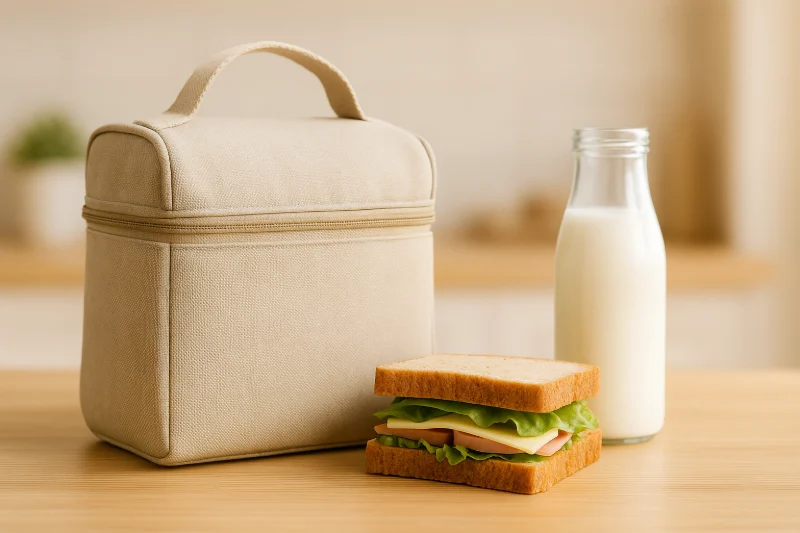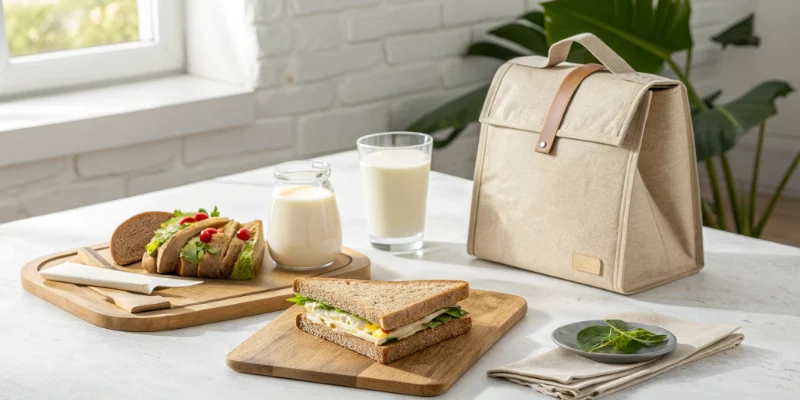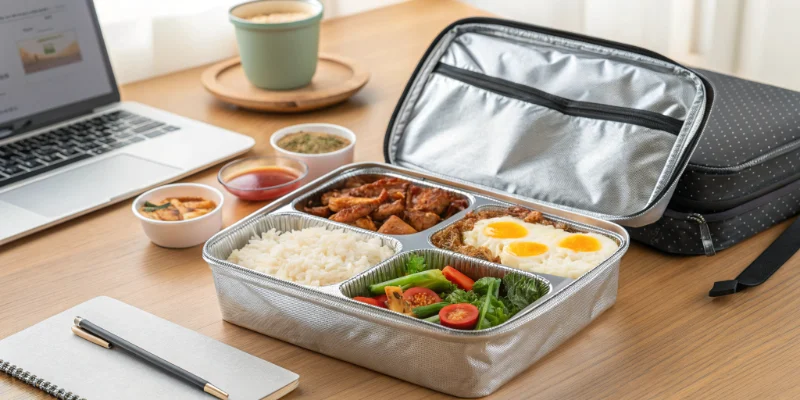
There’s nothing quite like enjoying a warm, comforting meal in the middle of a busy day. Whether you’re at work, school, or on the go, a hot lunch instantly lifts your mood and keeps your energy up. But keeping food warm until lunchtime isn’t always easy—especially when you’re relying on a regular lunch bag.
Fortunately, you don’t need any complicated gadgets or reheating steps. With a few simple tricks and the right insulated bag, you can keep your meal warm for hours, just as if it were freshly made. In this guide, we’ll walk you through practical ways to extend the warmth of your food, from smart packing techniques to the right choice of bag materials.
Using an insulated lunch box or a vacuum food jar can significantly slow down heat loss, whereas ordinary plastic containers or poorly sealed lids allow the temperature to drop rapidly.
The performance of an insulated bag mainly depends on its material thickness, number of structural layers, and closure design. In general, the thicker the bag, the more layers it has, and the tighter the seal, the longer it can keep food warm.
Weather temperature, humidity, and storage location all influence heat retention. For instance, placing the insulated bag on a cold floor or near an air-conditioning vent will cause food to cool down much faster.
Warm your food to at least 74°C (165°F). This temperature not only ensures better taste but also meets food safety recommendations, helping extend the time your meal stays warm inside the insulated bag. The higher the initial temperature of the food, the slower the heat will dissipate.
For soups or stews, place them in a thermal food jar or vacuum container before putting them inside the insulated bag. If your meal contains sauces or liquids, make sure to use a well-sealed container to prevent leaks that can cause rapid temperature loss.
Wrap hot food first in aluminum foil, then cover it with a towel or cloth. This double insulation method significantly improves overall heat retention and slows down temperature loss.
Some insulated lunch bags on the market come with built-in heating wires or USB connections, allowing them to be powered by a portable charger during commutes. These are “actively heated” bags rather than traditional “passive insulation” types. While they offer stronger temperature maintenance, they fall outside the main scope of this article.
They are more suitable for scenarios that require long-term heat retention, such as food delivery or long-distance transport. For daily lunch use, a regular insulated bag combined with proper preheating techniques is usually sufficient.

Air is the biggest channel for heat to escape. If the bag has too much empty space, warm air circulates quickly and causes food to cool faster. You can fill the gaps with towels, cloths, or paper napkins to make the containers fit snugly, creating a more stable thermal environment. This method works especially well when carrying multiple lunch boxes or meal portions.
In addition to passive insulation, you can place a reusable heat pack or a bottle filled with hot water inside the bag to help maintain the temperature for a longer time.
Be careful not to let these heat sources come into direct contact with food, as that may cause localized overheating or container deformation. Place a layer of cloth or paper between the heat source and the food to create a safe thermal barrier.
After packing, seal the bag immediately to prevent heat from escaping. The tighter the closure, the slower the internal temperature drops.
It’s best to choose insulated bags with zipper or Velcro closures, as both effectively reduce heat loss. During use, try to minimize how often you open the bag to keep the internal temperature stable.
An insulated bag cools down much faster in cold surroundings. Avoid placing it directly on the ground, inside a car, or near air-conditioning vents—these surfaces and spaces are cold and draw heat away quickly. Ideally, keep the bag in a warm, dry, and sheltered spot, or place a piece of cloth or cushion underneath during winter to reduce contact with cold surfaces.
Frequent movement or shaking increases air circulation inside the bag, causing uneven temperature distribution and faster heat loss. It’s best to keep the bag in a fixed position until mealtime. Opening it only when needed helps maintain warmth more effectively.
Each time you open the bag, a large amount of heat escapes. Try to remove all food items at once instead of repeatedly opening and closing it. If you need to take food out several times, plan ahead and place the items you’ll eat first near the top to shorten the opening time.
| Type of Insulated Bag | Average Heat Retention | Tips to Extend Warmth |
|---|---|---|
| Standard insulated bag | 2–4 hours | Heat food thoroughly, fill empty spaces with towels |
| Premium/double-layer insulated bag | 4–6 hours | Preheat the bag, use heat packs to assist |
| Electric heated bag | 6+ hours | Best for food delivery or catering transport |
When selecting an insulated bag, consider the following factors to ensure both functionality and comfort:
Common outer materials include canvas, laminated non-woven fabric, laminated woven polypropylene (PP), Tyvek®, and washable kraft paper. Each offers a different balance of appearance, strength, and water resistance.

Choose the right size according to your needs. Compact models work well for individual lunches, while larger-capacity designs are better suited for families or group outings.
The tighter the seal, the slower the heat escapes. Zippers and Velcro closures are the most common designs—both effectively prevent air exchange and help maintain internal temperature.
Options include handheld, double-handle, or adjustable shoulder strap designs. For frequent use, look for reinforced stitching and sturdy construction to ensure durability.
Aluminum foil linings reflect heat efficiently, making them ideal for long-term insulation, while PEVA linings are soft, waterproof, and easy to clean—perfect for daily use.

Some insulated bags come with added convenience features such as exterior pockets, interior dividers, dual-layer tops, or bottle holders to help organize items. Others include adjustable straps or reinforced bases for added stability and comfort during transport.
The number of structural layers in an insulated bag is one of the most critical factors determining its heat retention performance.
Typically, a three-layer structure is the most common design—consisting of an outer fabric, a middle insulation layer, and an inner lining. The outer layer provides shape and protection, the insulation layer retains heat, and the inner lining directly contacts food, offering waterproofing, oil resistance, and easy cleaning.
Small details can make a big difference in how well your insulated bag performs. The following common mistakes are often the reason food cools too quickly or unevenly:
Filling the bag too tightly blocks air circulation, preventing heat from distributing evenly. Leave a bit of space inside to help maintain consistent warmth.
Every time you open the bag, valuable heat escapes, leading to a noticeable temperature drop. Try to take everything out in one go instead of reopening the bag multiple times.
Placing hot meals and cold drinks together affects both temperatures, leaving neither at the ideal level. Store them separately or choose a model with divided compartments.
Putting hot food directly into a cold container causes an instant temperature drop. Preheat the container with hot water for a few minutes—a simple step that’s often overlooked but makes a big difference in heat retention.
Beyond insulation performance, the reusability and eco-friendliness of cooler bags have become important considerations for many users. Different materials vary significantly in terms of lifespan, durability, and overall sustainability value.
Although almost all cooler bags can be reused, their level of durability and environmental impact differs by material. Canvas, washable kraft paper, and laminated PP woven fabric are among the most durable and long-lasting options. These materials offer excellent structural stability and abrasion resistance, making them ideal for extended use. As a result, they contribute more effectively to reducing waste and extending the product life cycle.
In contrast, non-woven fabric, especially heat-pressed versions, is lightweight and affordable but has limited durability. It’s often used for food delivery or short-term events—making it a practical yet “semi-disposable” option.
Thicker, sewn non-woven bags can be reused several times, but their lifespan remains shorter than that of woven or canvas alternatives.
For brand clients, the choice of material is not only about usage longevity but also reflects a company’s commitment to sustainability. If your goal is to create long-lasting promotional cooler bags or corporate gift bags, more structured and eco-friendly materials are recommended. For short-term events or food delivery packaging, non-woven options may be more cost-effective.

Whether for work, school, or outdoor picnics, the right cooler bag helps you enjoy a freshly cooked meal anytime. Extending your food’s warmth is not complicated—simply heat it thoroughly, preheat your insulated bag, choose a proper container, and seal and fill the bag carefully. These small details can help your meal stay hot longer without sacrificing taste or texture.
Meanwhile, the material and structure of your cooler bag also determine its durability and sustainability. By choosing a model that fits your frequency of use, purpose, and budget, you can not only improve daily convenience but also reduce single-use packaging waste—making your warm meals more sustainable and long-lasting.
Using an insulated cooler bag correctly isn’t just about maintaining temperature—it’s also a small way to slow down your pace of life and take care of yourself and your family.
Want to keep your lunch warm wherever you go? Choosing the right insulated bag makes all the difference.
Yanxin Bag has over a decade of manufacturing experience, offering a wide range of customizable styles—from lightweight insulated lunch bags to high-performance cooler bags, all designed to meet different insulation needs.
If you’re looking for a reliable cooler bag manufacturer or want to learn more about how to keep food warm for longer, contact Yanxin Bag for expert advice and custom solutions.
Want to understand the cooling mechanism behind lunch bags?
This article introduces the internal structure and functionality of insulated lunch bags by explaining the role of outer materials, lining choices, insulation layers, and zipper sealing — showing how each part helps maintain food temperature.
Curious whether all cooler bags perform equally?
This article breaks down the advantages and limitations of insulated cooler bags by analyzing design structure, insulation effectiveness, use scenarios, and cleaning ease, providing a balanced view of their practical value and trade-offs.
Wondering which materials hold up best on the outside?
This article outlines common outer materials used for cooler bags, comparing their durability, feel, style, and appropriate uses. It also touches on how combining different layers and materials affects the bag’s overall performance.
Need help cleaning your cooler bag the right way?
This article provides specific cleaning methods tailored to different cooler bag materials, including non-woven, polyester, cotton, laminated, and Tyvek types — detailing how to wash, dry, and care for each to extend product life.
Looking for a complete cooling strategy from prep to use?
This article covers the full usage process of cooler bags — including how to pre-chill the bag and its contents before heading out, how to pack efficiently, and practical tips for keeping the bag cold during transport and use.
Get a free quote and expert consultation today. Let's bring your brand vision to life.
1 Understanding foods with higher water content can help you choose meals that stay warm longer, enhancing your dining experience.
2 Learn about the effectiveness of using a sealed bottle filled with hot water to maintain food warmth during transport.
3 Explore this link to understand how EPE foam enhances insulation performance and heat retention.
Answer: Food can typically stay warm in an insulated bag for 2 to 6 hours, depending on the quality of insulation, the food’s initial temperature, and the outside environment. Preheating the bag and using heat packs can help extend the warmth duration.
Answer: Yes, insulated grocery bags can keep food hot for a few hours. These bags have thermal layers that trap heat, but for better results, use preheated containers and ensure the bag is tightly closed to minimize air circulation.
Answer: Yes, most reusable cooler bags are made from durable materials like nonwoven fabric, canvas, or RPET, making them environmentally friendly alternatives to single-use plastic bags.
Answer: Yes, cooler bags work both ways — they can keep food warm or cold. Their multi-layer insulation minimizes heat transfer, making them suitable for transporting hot meals and beverages.
Answer: Place a sealed bottle of hot water or a warm towel inside the insulated lunch bag for several minutes, then remove it before packing your food. Avoid pouring hot water directly into the bag, as this may damage non-waterproof linings.
Answer: Yes, if paired with vacuum-sealed or stainless steel food jars, insulated lunch bags can maintain the warmth of soups and stews for several hours. Ensure lids are tightly sealed to prevent leaks.
Answer: Common mistakes include overpacking, leaving air gaps, mixing hot and cold items, or failing to preheat containers. Opening the bag too often also allows heat to escape rapidly.
Answer: Most insulated lunch bags can be wiped clean with a damp cloth and mild detergent. Avoid soaking or machine washing if the bag has aluminum foil or foam insulation layers.
Answer: Thermal bags are typically smaller and designed for short-term food insulation, such as lunches. Cooler bags, however, have thicker insulation layers and better sealing structures, suitable for long-distance transport or outdoor activities.

Order or no-order we are Always here to help you!
We will contact you within 1 working day, please pay attention to the email with the suffix “@yanxinbag.com”.
Order or no-order we are Always here to help you!
We will contact you within 1 working day, please pay attention to the email with the suffix “@yanxinbag.com”.